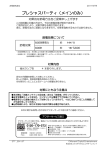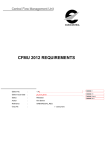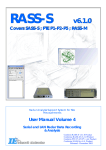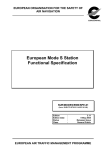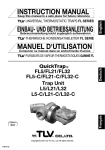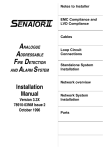Download Site Monitor Demonstrator
Transcript
EUROPEAN ORGANISATION FOR THE SAFETY OF AIR NAVIGATION EUROCONTROL EUROCONTROL EXPERIMENTAL CENTRE SITE MONITOR DEMONSTRATOR EEC Note No. 28/96 EEC Task C07 EATCHIP Task SUR.3 Issued: December 1996 The information contained in this document is the property of the EUROCONTROL Agency and no part should be reproduced in any form without the Agency’s permission. The views expressed herein do not necessarily reflect the official views or policy of the Agency. REPORT DOCUMENTATION PAGE Reference: EEC Note No. 28/96 Security Classification: Unclassified Originator: EEC - COM (Communication) Originator (Corporate Author) Name/Location: EUROCONTROL Experimental Centre B.P.15 F - 91222 Brétigny-sur-Orge CEDEX FRANCE Telephone : +33 1 69 88 75 00 Sponsor: EATCHIP Development Directorate Sponsor (Contract Authority) Name/Location: EUROCONTROL Agency Rue de la Fusée, 96 B -1130 BRUXELLES Telephone : +32 2 729 9011 TITLE: SITE MONITOR DEMONSTRATOR Authors Date Pages Figures Photos Appendix References 12/96 iv+18 4 2 0 6 Hans P. ENGLMEIER João M. M. MARTINS EATCHIP Task Specification SUR.3 EEC Task No. C07 Task. No Sponsor Period 4/96 to 11/96 Distribution Statement: (a) Controlled by: Head of COM (b) Special Limitations: None (c) Copy to NTIS: YES / NO Descriptors (keywords): Mode-S Subnetwork - Aircraft Equipment Simulation - ARINC Protocols - Site Monitor Demonstrator HP-UX Environment - Remote Access - Advanced ARINC Card - HP UX C Abstract: This report describes the software architectural design and user manual of the Site Monitor Demonstrator. This document has been collated by mechanical means. Should there be missing pages, please report to: EUROCONTROL Experimental Centre Publications Office B.P. 15 91222 - BRETIGNY-SUR-ORGE CEDEX France EEC Note No. 28/96 EEC Task No. C07 EATCHIP Task No. SUR.3 Issued : December 1996 Site Monitor Demonstrator by Hans Peter ENGLMEIER and João Manuel MATEUS MARTINS EUROCONTROL Experimental Centre Summary This report describes the software architectural design and user manual of the Site Monitor Demonstrator Site Monitor Demonstrator iii CONTENTS 1. ACRONYMS AND ABBREVIATIONS DEFINITIONS.......................................................................... 1 2. PURPOSE AND SCOPE............................................................................................................................ 2 3. INTRODUCTION...................................................................................................................................... 2 4. MAJOR FEATURES OF THE SITE MONITOR DEMONSTRATOR .................................................. 3 5. GENERAL OVERVIEW........................................................................................................................... 4 6. SITE MONITOR DEMONSTRATOR SOFTWARE ARCHITECTURAL DESIGN ............................ 6 7. SITE MONITOR DEMONSTRATOR USER MANUAL ........................................................................ 8 7.1. INTRODUCTION .......................................................................................................................................... 8 7.2. INSTALLING THE SITE MONITOR DEMONSTRATOR ....................................................................................... 8 7.3. RUNNING THE SITE MONITOR DEMONSTRATOR........................................................................................... 9 7.4. SITE MONITOR DEMONTRATOR OPERATING INSTRUCTIONS........................................................................ 10 7.4.1. GICB Editor .................................................................................................................................... 10 7.4.2. Main User Interface......................................................................................................................... 14 7.4.2.1. Flight Data ................................................................................................................................... 14 7.4.2.1.1. Low Security Level ..................................................................................................................... 14 7.4.2.1.2. High Security Level.................................................................................................................... 14 7.4.2.1.3. Change Password..................................................................................................................... 15 7.4.2.2. Downlink Messages....................................................................................................................... 15 7.4.2.2.1. On Line Messages ..................................................................................................................... 15 7.4.2.2.2. Pre-defined Messages ............................................................................................................... 15 7.4.2.3. Quit Site Monitor Demontrator ................................................................................................ ..... 17 7.4.3. Final Considerations........................................................................................................................ 17 8. REFERENCES......................................................................................................................................... 18 PHOTO N° 1 .................................................................................................................................................. 1 PHOTO N° 2 .................................................................................................................................................. 2 Site Monitor Demonstrator iv 1. Acronyms and Abbreviations Definitions AAC Advanced ARINC Card ACAS Aircraft Collision Avoidance System ADLP Aircraft Data Link Processor Unit ATN Aeronautical Telecommunication Network BDS Binary Data Store. Register number with 56 bit in the Mode S transponder. CTS Clear to send DLPU Data Link Processor Unit ELM Extended Length Message GDLP Ground Data Link Processor GICB Ground Initiated Comm-B Messages IIMSES Initial Implementation Mode-S in Enhanced Surveillance RTS Request to send SLM Short Length Message SMD Site Monitor Demonstrator SNTF Sub-Network Test Facility TUB Technische Universität Braunschweig XPDR Mode S Transponder Site Monitor Demonstrator 1 2. Purpose and Scope The purpose of this document is to provide an overall description of the software architectural design and user manual of the Site Monitor Demonstrator test tool developed at the EUROCONTROL Experimental Centre. 3. Introduction The Site Monitor Demonstrator is part of the IIMSES programme and is a test tool for the radar stations involved in this programme. This will be an industrial product, the EEC produces it only as a demonstrator. Site Monitor Demonstrator 2 4. Major Features of the Site Monitor Demonstrator Site Monitor Demonstrator GICB EDITING MESSAGES EDITING GICB GENERATION DOWNLINK MESSAGES GENERATION DATA LINK MONITORING FLIGHT IDENTIFICATION EDITING and GENERATION CONTROL WORD EDITING and GENERATION FLIGHT ALTITUDE EDITING and GENERATION ARINC 718 PROTOCOL GENERATION ARINC 429 PROTOCOL GENERATION Figure no. 1 - Major features of the Site Monitor Demonstrator The Site Monitor Demonstrator test tool is a software device Installed in a HP-UX workstation and using an Advanced ARINC Card version 2 /1/. Site Monitor Demonstrator 3 The SMD software has two major functionalities. The first, is the capacity of generate and monitor Mode-S data link messages, using an ARINC 718 protocol, and the second, is the capacity of generate flight identification, control word and flight altitude broadcast messages using an ARINC 429 protocol. 5. General Overview Mode S Antenna Mode S Radar ARINC 718 caring Mode S Messages RADAR XPDR S W IT C H B O X D E L A Y L IN E S REMOTE CONTROL P C A R IN C CARD S IT E M O N IT O R DLPU ARINC 429 caring Flight Identification Control Word Flight Altitude Network Protocol Figure no. 2 - General overview of a SMD environment There are two differences between normal grounded aircraft equipment and the SMD : The first, is a delay line installed in a parrot transponder near the radar to put it at a longer distance /2/. The second, is the existence of a special device, a DLPU or a ADLP, which can also execute the functions of the transponder control box and the altimeter. This device can be realised by a workstation with a PC ARINC card /1/. Installed in a network environment it can be used in a remote mode. The ARINC card has two receivers and 4 multiplexed transmitters. It uses a Harris ARINC processor which allows different transmission speeds for reception and transmission. Site Monitor Demonstrator 4 Two high speed receivers and two high speed transmitters are used for the ARINC 718 interface between the (American) transponder and the SMD. The two remaining transmission channels are used in the following way: one, for the transmission of the control word, channel 3, and the other, for the transmission of the altitude and flight identification, channel 4. Both channels use low speed transmission. The firmware on the AAC can implement a single ARINC 718 channel with the transponder, “xpdrx.exe”, or a double “xpdrdax.exe”. The software of the workstation is an upgraded version of TDLP including control box and altimeter functions. In the EEC Mode S avionics test chain, a switch is installed to take the ARINC 429 broadcast for control word, altitude and flight identification either from the control box and altimeter, or from the SMD. The objective of the site monitor is to allow a radar operator or the ground control, the variation of all aircraft parameters sent to the parrot transponder including control word, altitude and flight identification. Further, all data link applications must be available for test purposes, including special cases as the transmission of 10 COMM-B between two radar beam hits, and verify whether the transponder has lost any data. Users for the site monitor are radar constructors and radar users. It is not excluded that the material of the EEC (delay lines and ARINC cards) will be used for the industrial SMD production. The SMD is a simple test tool and has nothing to do with the end to end test chain for data link applications foreseen in the ATN program, the Sub Network Test Facility SNTF. Nevertheless, the SMD upgraded by an interface to the GDLP could be a part of the end to end test chain mention above. If this option is accepted, the workstation of the SMD could house the software to be developed. In the moment the SMD is compatible with actual used DLPU, but in a near future, it must be slightly modified to be compatible with the ADLP. This is due to the implementation of the GDLP. Site Monitor Demonstrator 5 6. Site Monitor Demonstrator Software Architectural Design 1- Uplink Monitor 2- User Interface F1 F2 5- Uplink Driver F5 F4 3- Downlink Monitor 4 - GICB Editor F3 6- Main Process F6 7- Downlink Driver F7 F8 F9 F10 10 Flight Data Monitor 9- AAC Interface High Level SMD part N0 N2 12- AAC Driver N1 Low Level SMD part ARINC 718 Bus 11- GICB Monitor Site Monitor Demonstrator installed in a HP-UX workstation Advanced Arinc Card version 2 board 13- AAC Firmware A0 8- GICB Generator A1 ARINC 429 Bus Figure no. 3 - SMD software architectural design Notes : 1. F1 to F10 are System V IPC facilities, shared memory and semaphores 2. N0 to N2 are HP-UX kernel data transfer blocks 3. A0 and A1 are ARINC channels Site Monitor Demonstrator 6 As shown above the SMD is basically an upgraded version of the UNIX based TDLP /3/. This software device can be split in three parts, the high level running in the HPUX workstation, the HP-UX driver to access the AAC and finally, the low level software running in the card, the firmware. The high level part performs the following tasks: AAC driver interface, user interfacing for editing downlink messages, GICBs generation, and finally data link monitoring including surveillance messages, flight identification, altitude and control word. This part was written in HP-UX C programming language. Since the application is running in a HP-UX operating system it became necessary to implement a HP-UX driver to access the card. This driver, developed by Hewlett-Packard France, can be configured accordingly with the chosen AAC interrupt level and memory address. The configuration manual of this driver is not included in this document but can be supplied by EUROCONTROL. Finally, the low level software running in the card, the firmware, implementing the high speed ARINC 718 /4/ and the low speed 429-14 /5/. For the firmware the following considerations about time and load processing can be made: The DLPU/ADLP of the SMD has to answer a RTS from the transponder within 4.0 milliseconds with a CTS. The answer may be delayed by 2.88 milliseconds if a low speed broadcast word has to be sent. The normal reaction time of the ARINC card to answer a RTS with a CTS is, on average, 0.7 milliseconds. So, the worse case delay for a CTS is 3.58 milliseconds, which is less than 4.0 milliseconds. There is only one ARINC transmitter with 4 multiplexed drivers and all information has to go through this transmitter. The following table shows the permanent data flow of the transmitter in milliseconds per second. Transmitter occupancy Control word update Altitude update Flight identification update BDS (normal) update Maximum update time 86.4 86.4 57.6 54.0 284.4 Figure no. 4 - ARINC transmitter permanent data flow More than 60% of the transmitter time is available for data link. The firmware architectural design and functional description are not included in this document but can be supplied by EUROCONTROL. Site Monitor Demonstrator 7 7. Site Monitor Demonstrator User Manual 7.1. Introduction The purpose of this chapter is to give a general overview of how a user can install and implement this software package and, at the same time, to describe how to use all the SMD software facilities. 7.2. Installing the Site Monitor Demonstrator The SMD software is archived in the file “site.tar”. In the subdirectory “users/jma/site” use the command “tar -xvf site.tar” to extract all related files. In the subdirectory “site/site.bin” execute the file “make0” to compile the source files which are located in the subdirectory “site/site.src”. After successful compiling the following executable files should be found. *“sitemain" Main process. “sitefldat” Flight data monitor. *“siteaac" AAC interface. *“siteup" Uplink driver. “sitedown" Downlink driver. *“sitedownmon" Downlink monitor. *“siteupmon" Uplink monitor. “siteuser" User main interface. “site" File script to start running the SM *“sitegigen" GICB generation. “sitegiedit" GICB editor. “sitegimon" GICB monitor. “gicb.dat” Default file with AVIONICS data “sem.ftok.site” IPC semaphores facilities reference file “shm.ftok.site” IPC shared memory facilities reference file . “xpdrcx.exe" AAC firmware Site Monitor Demonstrator 8 * Note : All screen output messages are recorded in a file with extension “.rec”. The complete list of files necessary to run the SMD should also include the HP-UX driver necessary to establish the connection between the AAC firmware and this software application. 7.3. Running the Site Monitor Demonstrator To start running the user should type "site". This script file before activating the 11 processes mentioned below asks the name of the GICB file used. If nothing is written, after having pressed <ENTER> key, the file “gicb.dat” is read by default, see Photo1. Each of the 11 processes activated are running in a single « hpterm » visual window, see Photo 2. SITE_FLIGHT_DATA_MONITOR ⇒ “sitefldat” SITE_DOWNLINK_DRIVER ⇒ “sitedown” SITE_UPLINK_DRIVER ⇒ “siteup” SITE_DOWNLINK_MONITOR ⇒ “sitedownmon” SITE_UPLINK_MONITOR ⇒ “siteupmon” SITE_AAC_INTERFACE ⇒ “siteaac” SITE_USER_MAIN_INTERFACE ⇒ “siteuser” SITE_MAIN_PROCESS ⇒ “sitemain” SITE_GICB_GENERATOR ⇒ “sitegigen” SITE_GICB_EDITOR ⇒ “sitegiedit” SITE_GICB_MONITOR ⇒ “sitegimon” Use the mouse to select the correspondent « hpterm » window. How to operate with all processes will be described in the next chapter. Site Monitor Demonstrator 9 7.4. Site Monitor Demontrator Operating Instructions 7.4.1. GICB Editor The GICB editor is an on line editor of simulated AVIONICS data. Data can be introduced having as parameters the BDS number, the resolution and the minimum and maximum value accepted. BDS 5 DATA RANGE RESOLUTION Airborne Format Surveillance Status Turn Indicator Bit Barometric Altitude 0, 7..14 0..3 0..1 50,175 ft ------------------------------25 ft 0..1 + 90° + 180° -----------0.0007 ° 0.0014 ° 0, 5,6 0..128 + 180° 50,175 ft --------------------2.816 ° 25 ft 0..1 + 90° + 180° -----------0.0007 ° 0.0014 ° Time Bit Latitude Longitude 6 Type Movement MOV_SPM Track Barometric Altitude Time Bit Latitude Longitude 10 Capability Report 20 Aircraft Identification Defined in the user main interface (Flight Data - <F1>) 30 Reserved for ACAS Use hexadecimal data to fill Site Monitor Demonstrator Use hexadecimal data to fill 10 BDS DATA RANGE RESOLUTION + 180° 4g + 180° 131,072 ft 0.18° 0.001 g 0.044° 8 ft 40 Flight Path Angle Flight Path Acceleration Corrected Angle of Attack Barometric Correction Altitude 50 Mach Number Computed Air Speed Track Angle True Track Angle Magnetic 4.096 Mach 1,024 Kt + 180° + 180° 0.001 Mach 0.5 Kt 0.044° 0.044° 60 Track Angle Magnetic Ground Speed Altitude Rate Static Air Temperature + 180° 2,048 Kt + 16,384 ft/min + 512° 0.044° 0.5 Kt 64 ft/min 0.5° 70 Selected Altitude Range Selected Heading Status Word 1 Status Word 2 65,536 ft + 180° 270 271 16 ft 0.8° Binary Input Binary Input 80 Selected Airspeed Selected Altitude Rate Selected Altitude Status Word 1 512 Kt 16,384 ft/min 45,536 ft Label 270 0.25 Kt 16 ft/min 16 ft Binary Input 90 Selected Mach Number Selected Altitude Rate Selected Altitude Status Word 2 4.096 Mach 16,834 ft/min 65,536 ft Label 271 0.002 Mach 16 ft/min 16 ft Binary Input AO Cross Track Error Vertical Deviation Acceleration 128 nm 2,048 ft +1g 0.004 nm 1 ft 0.016 g BO Computer Airspeed True Airspeed Mach Heading (magnetic) 1,024 Kt 2,048 Kt 4.096 Mach + 180° 0.25 Kt 0.5 Kt 0.00025 Mach 0,18° Site Monitor Demonstrator 11 BDS DATA RANGE RESOLUTION CO Radio Height Average Static Pressure Altitude 8,192 ft 1,024 mb 131,072 ft 1 ft 0.25 mb 1 ft 31 Bearing to Waypoint Time to Go Distance to go + 180° 399.9 min 399.9 nm 0.18° 0.1 min 0.1 nm 41 Active Waypoint 1 Active Waypoint 2 Desired Track 3 characters 3 characters + 180° ISO 5 ISO 5 0.18° 51 Latitude Longitude Altitude + 90° + 180° 131,072 ft 0.00035° 0.0007° 8 ft 61 G.M.T. Flight Number HHMMSS xxxx 71 Roll Angle Altitude Rate Wind Speed Wind Angle + 90° + 8,192 ft/min 256 Kt + 180° 0,35° 128 ft/min 1 Kt 0.703° 24 Centre of Gravity Gross Weight 99.9 % 131,072 lbs 0.1 % 160 lbs Site Monitor Demonstrator 12 BDS DATA RANGE RESOLUTION 17 N1 Actual Engine # 1 Fuel Flow Engine # 1 Total Air Temperature Static Air Temperature 256 % rpm 32,768 lb/hr ± 512°C ± 512°C 0.13 % rpm 8 lb/hr 0.5°C 0.5°C 27 N1 Actual Engine # 2 Fuel Flow Engine # 2 Total Air Temperature Static Air Temperature 256 % rpm 32,768 lb/hr ± 512°C ± 512°C 0.13 % rpm 8 lb/hr 0.5°C 0.5°C 37 N1 Actual Engine # 3 Fuel Flow Engine # 3 Total Air Temperature Static Air Temperature 256 % rpm 32,768 lb/hr ± 512°C ± 512°C 0.13 % rpm 8 lb/hr 0.5°C 0.5°C 47 N1 Actual Engine # 4 Fuel Flow Engine # 4 Total Air Temperature Static Air Temperature 256 % rpm 32,768 lb/hr ± 512°C ± 512°C 0.13 % rpm 8 lb/hr 0.5°C 0.5°C 1A Aircraft Identification Aircraft Identification Aircraft Identification 2 char. ISO5 2 char. ISO5 2 char. ISO5 Label 233 Label 234 Label 235 1B Aircraft Identification 2 char. ISO5 Label 236 Site Monitor Demonstrator 13 7.4.2. Main User Interface This process allows the user to terminate a session and to edit or to send downlink messages including aircraft flight data. 7.4.2.1. Flight Data To chose this option type function key <F1>. 7.4.2.1.1. Low Security Level To chose this option type function key <F1> and complete the following displayed table. Type <ENTER> to finish. LOW SECURITY LEVEL FLIGHT IDENTIFICATION ( max. 8 alfan. char.) FLIGHT ALTITUDE (min. value of 43000 ft) Confirm it by typing <y>, <Y> or <ENTER>. To cancel it type <N> or <n>. 7.4.2.1.2. High Security Level To chose this option type function key <F2>. To proceed, a password must be enter. Type <ENTER> to finish. WRITE PASSWORD If an incorrect password is entered, the following message will be displayed and the process will return to the main menu. SORRY, BUT YOU HAVE A WRONG PASSWORD ! TRY AGAIN. If a correct password is entered, complete the following displayed table. Type <ENTER> to finish. HIGH SECURITY LEVEL FLIGHT IDENTIFICATION ( max. 8 alfan. char.) FLIGHT ALTITUDE CONTROL WORD CODE ( 4 octal char.) Confirm it by typing <y>, <Y> or <ENTER>. To cancel it type <N> or <n>. Site Monitor Demonstrator 14 7.4.2.1.3. Change Password To chose this option type function key <F3>. Complete the following displayed table. WRITE OLD PASSWORD If an incorrect password is introduced , the following message will be displayed and the process will return to the main menu. SORRY, BUT YOU HAVE A WRONG PASSWORD ! TRY AGAIN. If a correct password is introduced, complete the following displayed table with the new password. WRITE NEW PASSWORD ( max. 8 alfan. char.) Confirm it by typing <y>, <Y> or <ENTER>. To cancel it type <N> or <n>. The new password will be written in file "paswrd.txt". 7.4.2.2. Downlink Messages To chose this option type function key <F2>. 7.4.2.2.1. On Line Messages To chose this option, type <F1>. Complete the following displayed table and type <ENTER> to finish. Confirm it by typing <y>, <Y> or <ENTER>.The maximum size of each message is 208 characters, which corresponds to a COMD of 16 segments (mode “atc” and 6 bit code) /6/. DOWNLINK MESSAGE ( max. 208 alfan. char.) If you want to send this message more then once, confirm it, by writing the corespondent number. For a single time, type <ENTER> or <1>. To quit type <0>. 7.4.2.2.2. Pre-defined Messages The file “mes.txt” contain all the pre-defined messages. These messages can be on line written or modified. The general format for these messages is: # x x Site Monitor Demonstrator y y ... ... ... ... ... y # 15 # - Start message indicator. x - Message number (decimal char. or function key). x - Message number (decimal char. or function key.).. - Space . y - Message (alph. char.) . # - Stop message indicator. In file “mes.txt” there are already 15 messages. They can be activated by typing the corresponding number, as follows: #1 COMB# #2 COMMB LINKED 2# #3 TEST COMM-B LINKED 3# #4 TEST COMM-B LINKED 4# #5 ...............TEST ELM COMM-D MESSAGE WITH 6 SEGMENTS ................# #6 .............. TEST ELM COMM-D MESSAGE WITH 10 SEGMENTS .................. TEST ELM COMM-D MESSAGE WITH 10 SEGMENTS# #7 .............. THIS IS A DOWNLINK MESSAGE FOR TESTING AN ELM WITH 16 SEGMENTS WITH APN = 1 .......................... THIS IS A DOWNLINK MESSAGE FOR TESTING AN ELM WITH 16 SEGMENTS WITH APN = 1# #8 AFR405 REQUEST FL345 AT NANTES WAYPOINT# #9 SAB546 REQUEST DIRECT ROUTING ON FL240 AT PARIS/ORLY# #10 TAP420 REQUEST METEO REPORT FOR EDDF# #11 LUF345 REQUEST ATIS INFORMATION FOR LPPO# #12 BRI345 REPORTING CB TURBULENCE AT FL300# #13 THY345 REPORTING UFO AT BRETIGNY REGION# #14 AFR345 REPORTING EMERGENCY 119.1# #15 TEST MESSAGE# Site Monitor Demonstrator ALL FREQUENCIES OFF LINE INCLUDING 16 #F1 REQUEST VOLMET AT ZONE LFPG # #F2 REQUEST TAF AT ZONE LFPG # #F3 REQUEST METAR AT ZONE LFPG # #F4 REQUEST PRELDG AT ZONE LFPG # #F5 REQUEST SIGMET AT ZONE LFPG # #F6 REQUEST ATIS INFORMATION LFPG # #F7 REQUEST ATIS INFORMATION FROM LFPG LFLY# All the messages activated by a function key are phrase coded /6/. These messages examples were used in PARIS region. The file “mes.txt” contain also the downlink radar identification which is on line modifiable. The format is: # x D I I I D E N T I F I C A T I O N x x x x Downlink radar identification ( use decimal char., max.=16, min.=1) 7.4.2.3. Quit Site Monitor Demontrator To chose this option type function key <F3>. Confirm it by typing <y>, <Y> or <ENTER>. To cancel it type <N> or <n>. 7.4.3. Final Considerations All the other processes do not require any user operation. Site Monitor Demonstrator 17 # 8. References [1] EEC Note No. 17/94 - "Advanced PC-ARINC Card version 2" by H.P. ENGLMEIER. [2] EEC Note No. 26/95 - "Remote Transponder" by H.P. ENGLMEIER. [3] EEC Note No. 16/95 - "Test Data Link Processor - UNIX version" by H.P. ENGLMEIER and J.M. Mateus Martins. [4] ARINC Document - Mark 3 "Air Traffic Control Transponder (ATCRBS / Mode S) ARINC Characteristic 718-4, 15.12.1989. [5] ARINC Document - Mark 33 "Digital Information Transfer System" ARINC Characteristic 429-12, 1.7.1990. [6] "User Manual for TUB Software in DLPU Model C2" 01/11/1992 by M. Lehmensiek. Site Monitor Demonstrator 18




























